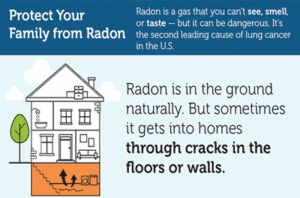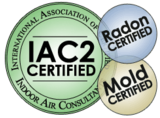With the cooler weather, we’re all spending more time indoors. It’s a great time to check to make sure your house is safe by doing radon testing.
Many people do this as part of a pre-purchase inspection, or even a pre-listing inspection, but it’s a good thing to do every 2-3 years. HomeTech offers a quick and easy Radon Test with results available within 48 hours. If your house is brand new or very old, every house should be tested for radon.

Radon gas can seep into a home from the soil through dirt crawlspaces, cracks in the foundation and walls, floor drains, pipes and sump pumps. This harmful gas can enter any home, old or new, even those with no visible cracks. Each building is unique and the ground under the house is also unique. Two houses side-by-side can have totally different levels. The only way to know what levels are inside your home is to measure them with radon testing.
Read on for more information on Radon from the Centers for Disease Control and Prevention
Radon is the second leading cause of lung cancer after cigarette smoking. If you smoke and live in a home with high radon levels, you increase your risk of developing lung cancer. Radon testing is the only effective way to determine whether you and your family are at risk of high radon exposure.
Radon is a radioactive gas that forms naturally when uranium, thorium, or radium, which are radioactive metals break down in rocks, soil and groundwater. People can be exposed to radon primarily from breathing radon in air that comes through cracks and gaps in buildings and homes. Because radon comes naturally from the earth, people are always exposed to it.
The U.S. Environmental Protection Agency and the Surgeon General’s office estimate radon is responsible for more than 20,000 lung cancer deaths each year in the U.S. When you breathe in radon, radioactive particles from radon gas can get trapped in your lungs. Over time, these radioactive particles increase the risk of lung cancer. It may take years before health problems appear.
People who smoke and are exposed to radon are at a greater risk of developing lung cancer. EPA recommends taking action to reduce radon in homes that have a radon level at or above 4 picocuries per liter (pCi/L) of air (a “picocurie” is a common unit for measuring the amount of radioactivity).
Your chances of getting lung cancer from radon depend mostly on:
- How much radon is in your home–the location where you spend most of your time (e.g., the main living and sleeping areas)
- The amount of time you spend in your home
- Whether you are a smoker or have ever smoked
- Whether you burn wood, coal, or other substances that add particles to the indoor air
The chances of getting lung cancer are higher if your home has elevated radon levels and you smoke or burn fuels that increase indoor particles.
Take Action with Radon Testing
The U.S. Department of Housing and Urban Development pdf icon[1 MB]external icon recommends additional actions you can take to reduce high radon levels in your home and protect yourself from an increased risk of lung cancer.
-
Stop smoking and discourage smoking in your home.
- Smoking significantly increases the risk of lung cancer from radon.
-
Increase air flow in your house by opening windows and using fans and vents to circulate air.
- Natural ventilation in any type of house is only a temporary strategy to reduce radon.
-
Seal cracks in floors and walls with plaster, caulk, or other materials designed for this purpose.
- Contact your state radon office for a list of qualified contractors in your area and for information on how to fix radon problems yourself. Always test again after finishing to make sure you’ve fixed your radon problem.
-
Ask about radon resistant construction techniques if you are buying a new home.
- It is almost always cheaper and easier to build these features into new homes than to add them later.

